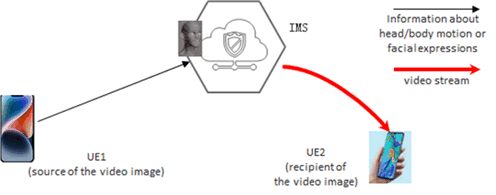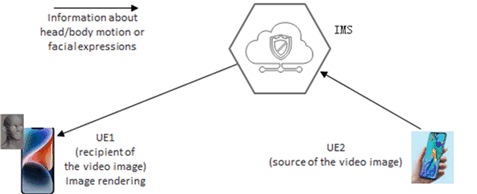Content for TR 22.856 Word version: 19.2.0
1…
5…
5.2…
5.3…
5.4…
5.5…
5.6…
5.7…
5.8…
5.9…
5.10…
5.11…
5.12…
5.13…
5.14…
5.15…
5.16…
5.17…
5.18…
5.19…
5.20…
5.21…
5.22…
5.23…
5.24…
5.25…
5.26…
5.27…
5.28…
6
7…
7.2
8
A
B
C…
5.16 Use Case on virtual store in a mobile metaverse marketplace
5.16.1 Description
5.16.2 Pre-conditions
5.16.3 Service Flows
5.16.4 Post-conditions
5.16.5 Existing features partly or fully covering the use case functionality
5.16.6 Potential New Requirements needed to support the use case
...
...
5.16 Use Case on virtual store in a mobile metaverse marketplace p. 57
5.16.1 Description p. 57
5G technologies especially the XR communication technologies make it possible to run business online (with or without physical offices/stores) to offer various services. Examples include fashion store online, drop-shipping business, virtual real estate agency, virtual assistants, teaching an online course, and online fitness training. Running a business online is particularly attractive for start-ups and small even medium sized businesses. For end consumers, visiting a market is a real feast for the senses. It is a multisensory experience that combines tradition with human contact and involves a series of decisions about which products to choose for the shopping basket.
Mobile metaverse services are expected to help to transfer a world so rich in sensations to the virtual sphere, which offer rich XR enabled multimedia communication services together with security mechanisms for data protection, user identity/profile management as well as digital asset management and protection. IMS based avatar calls are among these new features/services, where AI avatar can be used to help facilitate social interactions. An AI avatar [61] [62] is a digital character powered by artificial intelligence, which lives in a virtual setting, like a game, social network or online world. More frequently avatars are designed as human-like bots that can be controlled by real human using AI technologies and can easily engage with real humans and maintain relationship - to varying degrees - with them.
5.16.2 Pre-conditions p. 57
Magnificent Muggles, a niche fashion company, has set up virtual stores in a metaverse marketplace (a mobile metaverse service) provided by GreenMobile. The corresponding 5G communication subscriptions provided by GreenMobile include the XR enabled multimedia communication services, including IMS based avatar calls) which enable the efficient near-real life interaction between the virtual shop assistant and the online shoppers, an immersive location agnostic service experience. As a fashion retailer, Magnificent Muggles expect to provide similar if not better experience to their online shoppers in their virtual stores. To enable this, they have their shop assistants equipped with XR devices to interact with online buyers. In their virtual stores, the end consumers can "see" the products as if they were buying them face-to-face and they can interact live with the people selling them.
As part of the service level agreement, GreenMobile provides storage and communication services to Magnificent Muggles:
- to store the digital representations (e.g. avatars) for the virtual shop assistance;
- to assist the authentication of their employees to use the digital representations (e.g. avatars) in the XR communication when assisting online buyers;
- to render the digital representations (e.g. avatars) based on the voice, facial expression or body motion of a human user.
5.16.3 Service Flows p. 58
0.1.
Magnificent Muggles register with GreenMobile (the provider of 5G communication services and the mobile metaverse service) the digital representation (e.g. avatar) to be used by the virtual shop assistants. Subject to regulatory requirements, the digital representation are then certified to be legally used in a certain region. The digital representations are stored at GreenMobile's edge sites.
0.2.
Mrs. Dursley, an end consumer, registers and stores her digital representations with GreenMobile to be used in the metaverse marketplace. Subject to regulatory requirements, the digital representations are then certified to be legally used in a certain region.
1.
Humphrey is the shop assistant in the Magnificent Muggles virtual store. Due to the ongoing pandemic he works from home. As part of the security requirements, he needs to be verified as an employee of Magnificent Muggles before having an XR communication with online buyers.
2.
Mrs. Dursley decides to pay a visit at the virtual store of Magnificent Muggles to check out the new clothing. Humphrey, the shop assistant, greets her and offers to set up an XR communication to show her around the new lines. Mrs. Dursley thinks a good idea and agrees. Having completed the authentication of the participants, the multimedia communication session is set up between Mrs. Dursley and Humphrey as well as the associated XR devices.
3.1.
For this session Humphrey uses one of the Magnificent Muggles registered digital representations. During the session, the terminal sends the audio and video data to the network. The network does the rendering of the digital image based on the voice, facial expression as well as the gesture, then sends to Mrs. Dursley's terminal.
- The body motion or facial expressions of Humphrey are captured at UE1, which is transmitted to the network.
- With the received information about the user's motion or facial expressions, the network renders the avatar (the dynamic 3D object).
- The media data (converted from the 3D object) is then transmitted to the recipient, UE2 of Mrs. Dursley.
- The video image (with the rendered avatar) is displayed at the screen of Mrs. Dursley's terminal.

Figure 5.16.3-1: An example of avatar call functional flow (image rendering at the network)
(⇒ copy of original 3GPP image)
(⇒ copy of original 3GPP image)
3.2.
Mrs. Dursley downloads, from the network, one of her registered digital representations to be used for the XR communication. During the session, the rendering is done at the terminal side. An example of the functional flow from Mrs. Dursley to Humphrey is illustrated in figure 5.16.3-2. Note that in this option the required 3D avatar model needs to be made available at all the recipients (UE1 in this option).
- The body motion or facial expressions of Mrs. Dursley are captured at UE2, which is transmitted to the recipient via the network.
- With the received information about Mrs. Dursley's motion or facial expressions, UE1 renders the avatar (the dynamic 3D object). The video image (with the rendered avatar) is displayed at the screen of Humphrey's terminal.

Figure 5.16.3-2: An example of avatar call functional flow (image rendering at the receiving side)
(⇒ copy of original 3GPP image)
(⇒ copy of original 3GPP image)
5.16.4 Post-conditions p. 59
The 3GPP system with a combination of various technologies offers the users an immersive shopping experience equivalent to a face-to-face purchase in a crowded market.
5.16.5 Existing features partly or fully covering the use case functionality p. 59
The service requirements on IMS Multimedia Telephony Service and supplementary services are well documented in TS 22.173 since Rel-7, many of which have been implemented in stage-2 and stage-3 WGs. The requirements on 3GPP IMS Multimedia Telephony Service are captured in clause 6.39 of TS 22.261 as a result of Rel-18 work.
On the user identity related aspects, there are several features defined including:
- Support of Multi-device and Multi-Identity in IMS MMTEL service is captured in clause 4.6 of TS 22.173: The support of multiple devices is inherent in IMS. In addition, a service provider may allow a user to use any public user identities for its outgoing and incoming calls. The added identities can but do not have to belong to the served user. Identities may be part of different subscriptions and different operators.
-
TS 22.101 has specified in clause 26a a set of service requirements on User Identity:
Identifying distinguished user identities of the user (provided by some external party or by the operator) in the operator network enables an operator to provide an enhanced user experience and optimized performance as well as to offer services to devices that are not part of a 3GPP network. The user to be identified could be an individual human user, using a UE with a certain subscription, or an application running on or connecting via a UE, or a device ("thing") behind a gateway UE. Network settings can be adapted and services offered to users according to their needs, independent of the subscription that is used to establish the connection. By acting as an identity provider, the operator can take additional information from the network into account to provide a higher level of security for the authentication of a user. The 3GPP System shall support to authenticate a User Identity to a service with a User Identifier.
- Clause 8 of TS 22.261 specifies the security related requirements covering aspects such as authentication and authorization, identity management, and data security and privacy.
- clause 7.6.1 AR/VR;
- clause 6.43 Tactile and multi-modal communication service;
- clause 7.11 KPIs for tactile and multi-modal communication service
- securely register and store the digital representations (e.g. avatars) for the users. The user could be an individual human user using a UE with a certain subscription, or an application running on or connecting via a UE, or a device behind a gateway UE. The user could also be a third party, which is typically an enterprise customer having service level agreement with the operator and interacting with the 3GPP network via an application server.
- assist the authorization of the use of third party's digital assets (e.g. the digital representations (e.g. avatars) in the XR communication. The third party is also involved in the procedure to certify the user identity (e.g. an employee of the company).
- when required render the digital representations (e.g. avatars) based on the voice, facial expression or gesture in the live communication video.
5.16.6 Potential New Requirements needed to support the use case p. 60
[PR 5.16.6-1]
Subject to user consent, the 5G system shall support mechanisms to securely register, store and update the digital assets for a user.
[PR 5.16.6-2]
Subject to regulatory requirements and operator's policy, the 5G system shall provide suitable and secure means to allow trusted third-party to authorize the use of the digital assets (that belong to the third-party enterprise customer) by a user.
[PR 5.16.6-3]
The 5G system shall be able to collect charging information per UE for managing (e.g. register, store and update) the digital assets for an end user (e.g. typically a human user with a certain subscription).
[PR 5.16.6-4]
The 5G system shall be able to collect charging information per application for managing (e.g. register, store and update) the digital assets for the third party (e.g. typically an enterprise customer having service level agreement with the operator).
[PR 5.16.6-5]
Subject to regulatory requirements and user consent, the 5G system shall support real-time transmission, between a UE and the network, of the body movement information (e.g. body motion or facial expressions) of a human user in order to ensure immersive voice/audio and visual experience.
[PR 5.16.6-6]
Subject to regulatory requirements, user consent and operator's policy, the IMS shall support the capabilities of rendering the avatar based on the body movement information (e.g. body motion or facial expression) of a human user.